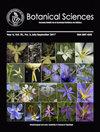Climatic amplitude is a predictor of geographic range size in Mexican morning glories (<em>Ipomoea</em> L., Convolvulaceae)
IF 0.7
4区 生物学
Q3 PLANT SCIENCES
引用次数: 0
Abstract
Background: Elucidating the determinants of species’ geographic distributions is a fundamental goal of ecology and biogeography, as they can inform about key biological processes, with implications for conservation. Goal: Evaluate whether realized climatic amplitude (a proxy for niche breadth) is an ecological correlate of geographic range size in morning glories in Mexico, a highly diverse group of plants of worldwide socio-economic relevance, but still poorly studied. Methods: Based on a dataset of > 30,000 records of which > 7,000 were manually georeferenced, we calculated geographic range size (using convex hull polygons and buffered occurrence points), and climatic amplitude (using three first axes of Principal Components based on 19 Worldclim variables, and focusing on temperature, precipitation, and seasonality), and explored their relationship using general linear models and phylogenetic generalized least squares. Results: All models show that climatic amplitude explains a high proportion of variation in geographic range size for our dataset (up to > 69 %). We find no evidence of tradeoffs related to temperature and precipitation niche breadths. Through review of reported records, we update the number of species of Ipomoea reported for Mexico to 178. Conclusions: Much of the variation in geographic range size in Mexican Ipomoea can be explained by realized climatic amplitude, and this result is not driven by phylogenetic history. We discuss cases where despite large geographic range sizes, narrow climatic amplitudes can signify higher risks for species in the face of changing environments.气候振幅是墨西哥牵牛花地理范围大小的预测因子(<em> ipomoe</em>旋花科植物L。)
背景:阐明物种地理分布的决定因素是生态学和生物地理学的一个基本目标,因为它们可以为关键的生物过程提供信息,对保护具有重要意义。
目标:评估实现的气候幅度(生态位宽度的代表)是否与墨西哥牵牛花的地理范围大小具有生态相关性,牵牛花是一种高度多样化的植物群,具有世界范围的社会经济意义,但研究仍然很少。
方法:基于>30,000条记录,其中>我们计算了地理范围大小(使用凸壳多边形和缓冲发生点)和气候幅度(使用基于19个Worldclim变量的主成分的三个第一轴,重点关注温度、降水和季节性),并使用一般线性模型和系统发育广义最小二乘探索了它们之间的关系。
结果:所有模式都表明,气候振幅解释了我们数据集地理范围大小变化的很大比例(高达>69%)。我们没有发现与温度和降水生态位宽度相关的权衡的证据。通过对报告记录的回顾,我们将墨西哥报告的Ipomoea的物种数量更新为178种。结论:墨西哥Ipomoea地区地理范围大小的大部分变化可以用实现的气候幅度来解释,而这一结果不是由系统发育历史驱动的。我们讨论了尽管地理范围很大,但面对不断变化的环境,狭窄的气候幅度可能意味着物种面临更高的风险的情况。
本文章由计算机程序翻译,如有差异,请以英文原文为准。
求助全文
约1分钟内获得全文
求助全文
来源期刊

Botanical Sciences
Agricultural and Biological Sciences-Plant Science
CiteScore
1.90
自引率
21.40%
发文量
71
审稿时长
16 weeks
期刊介绍:
Botanical Sciences welcomes contributions that present original, previously unpublished results in Botany, including disciplines such as ecology and evolution, structure and function, systematics and taxonomy, in addition to other areas related to the study of plants. Research reviews are also accepted if they summarize recent advances in a subject, discipline, area, or developmental trend of botany; these should include an analytical, critical, and interpretative approach to a specific topic. Acceptance for reviews will be evaluated first by the Review Editor. Opinion Notes and Book Reviews are also published as long as a relevant contribution in the study of Botany is explained and supported.
 求助内容:
求助内容: 应助结果提醒方式:
应助结果提醒方式:


